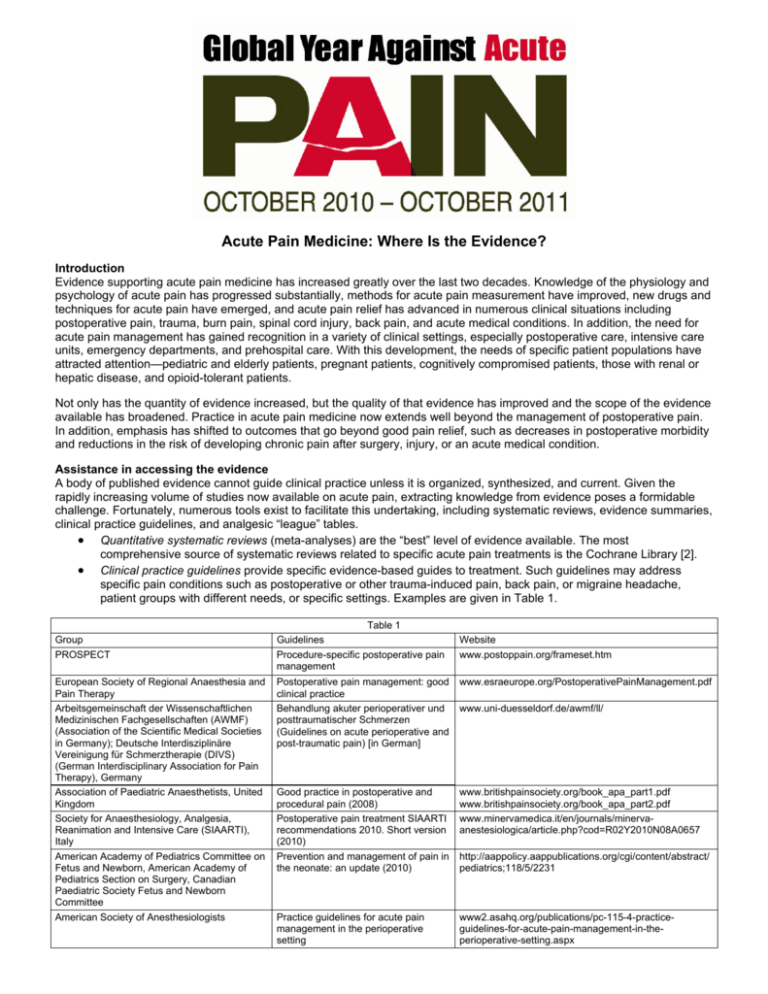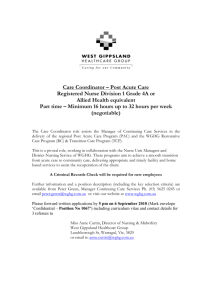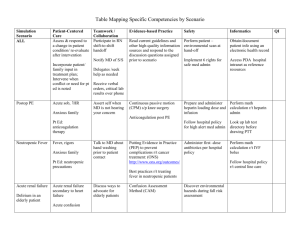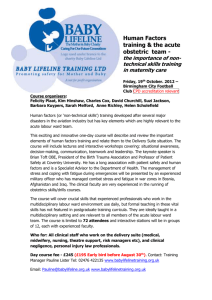Acute Pain Medicine: Where Is the Evidence?
advertisement

Acute Pain Medicine: Where Is the Evidence? Introduction Evidence supporting acute pain medicine has increased greatly over the last two decades. Knowledge of the physiology and psychology of acute pain has progressed substantially, methods for acute pain measurement have improved, new drugs and techniques for acute pain have emerged, and acute pain relief has advanced in numerous clinical situations including postoperative pain, trauma, burn pain, spinal cord injury, back pain, and acute medical conditions. In addition, the need for acute pain management has gained recognition in a variety of clinical settings, especially postoperative care, intensive care units, emergency departments, and prehospital care. With this development, the needs of specific patient populations have attracted attention—pediatric and elderly patients, pregnant patients, cognitively compromised patients, those with renal or hepatic disease, and opioid-tolerant patients. Not only has the quantity of evidence increased, but the quality of that evidence has improved and the scope of the evidence available has broadened. Practice in acute pain medicine now extends well beyond the management of postoperative pain. In addition, emphasis has shifted to outcomes that go beyond good pain relief, such as decreases in postoperative morbidity and reductions in the risk of developing chronic pain after surgery, injury, or an acute medical condition. Assistance in accessing the evidence A body of published evidence cannot guide clinical practice unless it is organized, synthesized, and current. Given the rapidly increasing volume of studies now available on acute pain, extracting knowledge from evidence poses a formidable challenge. Fortunately, numerous tools exist to facilitate this undertaking, including systematic reviews, evidence summaries, clinical practice guidelines, and analgesic “league” tables. • Quantitative systematic reviews (meta-analyses) are the “best” level of evidence available. The most comprehensive source of systematic reviews related to specific acute pain treatments is the Cochrane Library [2]. • Clinical practice guidelines provide specific evidence-based guides to treatment. Such guidelines may address specific pain conditions such as postoperative or other trauma-induced pain, back pain, or migraine headache, patient groups with different needs, or specific settings. Examples are given in Table 1. Group PROSPECT European Society of Regional Anaesthesia and Pain Therapy Arbeitsgemeinschaft der Wissenschaftlichen Medizinischen Fachgesellschaften (AWMF) (Association of the Scientific Medical Societies in Germany); Deutsche Interdisziplinäre Vereinigung für Schmerztherapie (DIVS) (German Interdisciplinary Association for Pain Therapy), Germany Association of Paediatric Anaesthetists, United Kingdom Society for Anaesthesiology, Analgesia, Reanimation and Intensive Care (SIAARTI), Italy American Academy of Pediatrics Committee on Fetus and Newborn, American Academy of Pediatrics Section on Surgery, Canadian Paediatric Society Fetus and Newborn Committee American Society of Anesthesiologists Table 1 Guidelines Procedure-specific postoperative pain management Website www.postoppain.org/frameset.htm Postoperative pain management: good clinical practice Behandlung akuter perioperativer und posttraumatischer Schmerzen (Guidelines on acute perioperative and post-traumatic pain) [in German] www.esraeurope.org/PostoperativePainManagement.pdf Good practice in postoperative and procedural pain (2008) Postoperative pain treatment SIAARTI recommendations 2010. Short version (2010) Prevention and management of pain in the neonate: an update (2010) www.britishpainsociety.org/book_apa_part1.pdf www.britishpainsociety.org/book_apa_part2.pdf www.minervamedica.it/en/journals/minervaanestesiologica/article.php?cod=R02Y2010N08A0657 Practice guidelines for acute pain management in the perioperative setting www2.asahq.org/publications/pc-115-4-practiceguidelines-for-acute-pain-management-in-theperioperative-setting.aspx www.uni-duesseldorf.de/awmf/ll/ http://aappolicy.aappublications.org/cgi/content/abstract/ pediatrics;118/5/2231 • • Comprehensive evidence summaries provide an up-to-date and general review of the “best available” evidence for the management of acute pain from many different etiologies, particularly postsurgical and post-traumatic causes including spinal injury and burns, as well as acute pain associated with various conditions such as migraine headache, herpes zoster, hematological disorders, or cancer. Evidence summaries also review and condense specific evidence on a given drug, analgesic technique, or pain condition. They also facilitate extrapolation of good evidence from one setting to another where specific high-quality evidence is lacking. Examples include extrapolation of evidence from animal to human, laboratory to clinical, or acute pain to chronic pain contexts. One example of a comprehensive evidence summary is Acute Pain Management: Scientific Evidence published by the Australian and New Zealand College of Anaesthetists and Faculty of Pain Medicine [3]. This document is not a clinical guideline. Analgesic league tables summarize evidence from randomized, double blind, single dose studies of individual drugs compared with placebo given to patients with moderate to severe pain [1]. These tables show the number needed to treat (NNT) for each drug. The NNT is the number of patients who must receive the active drug in order to achieve at least 50% pain relief in one patient over a 4- to 6-hour treatment period, compared with a placebo. Interpretation of such results requires caution. Applying evidence in clinical practice “Evidence-based medicine is the conscientious, explicit and judicious use of current best evidence in making decisions about the care of individual patients” “Good doctors and health professionals use both individual clinical expertise and the best available external evidence, and neither alone is enough” [4]. While the best available evidence can and should guide the management of acute pain, current evidence has limited quality, applicability, and generalizability. Clinical trials focus on the means of patient samples, but practicing clinicians treat one patient at a time. Few patients approximate the mean of a sample, and individual variation is substantial. Clinicians must take into account the factors that are unique to each case as well as the published evidence when managing acute pain. References [1] Bandolier. Oxford league table of analgesics in acute pain. 2007. Available at: http://www.medicine.ox.ac.uk/bandolier/booth/painpag/Acutrev/Analgesics/Leagtab.html. [2] Cochrane Collaboration. Cochrane library. Available at: http://www.thecochranelibrary.com/view/0/index.html. [3] Macintyre PE, Scott DA, Schug SA, Visser EJ, Walker SM. Acute pain management: scientific evidence, 3rd edition. Melbourne: Australian and New Zealand College of Anaesthetists and Faculty of Pain Medicine; 2010. Available at: http://www.anzca.edu.au/fpm/resources/books-and-publications. [4] Sackett DL, Rosenberg WM, Gray JA, Haynes RB, Richardson WS. Evidence based medicine: what it is and what it isn’t. BMJ 1996;312:71–2. Available at: http://www.ncbi.nlm.nih.gov/pmc/articles/PMC2349778/. © 2010 International Association for the Study of Pain ®








